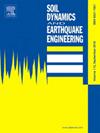评估大震级俯冲地震导致的土壤液化
IF 4.2
2区 工程技术
Q1 ENGINEERING, GEOLOGICAL
引用次数: 0
摘要
在过去的特大地壳地震中,曾多次观察到土壤液化导致的基础设施破坏,造成重大的材料和结构功能损失。在大多数地震区,土壤液化潜势的评估采用的是 Seed 和 Idriss 最初于 1971 年提出的基于循环应力的简化程序的更新版本。然而,这些程序在大震级(Mw > 7.5)俯冲地震中的应用表明,前瞻性预测与现场观测之间存在差异,尤其是在液化触发和表现方面。本文提出了一个替代模型,根据过大孔隙水压力比和剪切变形来评估大震级俯冲地震引起的土壤液化。触发标准基于临界可液化土层内预计的过剩孔隙水压力比和剪切应变的峰值。该模型将可液化层厚度和相对密度以及输入运动的累积绝对速度(CAV)作为土壤液化的主要预测因素。为此,首先开发了一个数值模型,并根据模拟自由场条件的动态离心机试验结果进行了验证。然后,利用校准后的数值模型进行数值参数研究,以确定受大震级俯冲地震影响的层状土壤沉积物的液化趋势和主要预测因素。最后,开发了一个简化的概率程序,并根据现有案例进行验证,以估算每个临界层内发生完全液化、边缘液化和无液化的概率。本文章由计算机程序翻译,如有差异,请以英文原文为准。
Assessing soil liquefaction due to large-magnitude subduction earthquakes
Infrastructure failure due to soil liquefaction has been repeatedly observed in past megathrust earthquakes, causing significant material and structural functionality losses. In most seismic regions, soil liquefaction potential is assessed using updated versions of the cyclic-stress-based simplified procedure initially proposed by Seed and Idriss in 1971. However, the application of these procedures to large-magnitude (Mw > 7.5) subduction earthquakes has shown discrepancies between forward predictions and field observations, particularly regarding liquefaction triggering and manifestation. This paper proposes an alternative model to assess soil liquefaction due to large-magnitude subduction earthquakes based on excess pore water pressure ratios and shear deformations. The triggering criteria are based on the peak values of excess pore pressure ratio and shear strain anticipated within the critical, potentially liquefiable soil layer. The model considers liquefiable layer thickness and relative density, along with input motion's Cumulative Absolute Velocity (CAV), as the main predictors of soil liquefaction. To this end, a numerical model was first developed and validated against results from a dynamic centrifuge test simulating free-field conditions. The calibrated numerical model was then used to perform a numerical parametric study to identify the trends and key predictors of liquefaction in layered soil deposits subjected to large-magnitude subduction earthquakes. Finally, a simplified probabilistic procedure, validated against available case histories, was developed to estimate the probabilities of full, marginal, and no liquefaction occurrence within each critical layer.
求助全文
通过发布文献求助,成功后即可免费获取论文全文。
去求助
来源期刊

Soil Dynamics and Earthquake Engineering
工程技术-地球科学综合
CiteScore
7.50
自引率
15.00%
发文量
446
审稿时长
8 months
期刊介绍:
The journal aims to encourage and enhance the role of mechanics and other disciplines as they relate to earthquake engineering by providing opportunities for the publication of the work of applied mathematicians, engineers and other applied scientists involved in solving problems closely related to the field of earthquake engineering and geotechnical earthquake engineering.
Emphasis is placed on new concepts and techniques, but case histories will also be published if they enhance the presentation and understanding of new technical concepts.
 求助内容:
求助内容: 应助结果提醒方式:
应助结果提醒方式:


